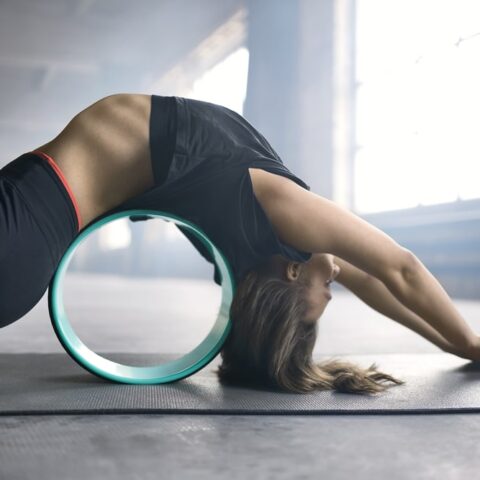Though they’ve been around for years, yoga wheels have recently gained popularity on social media platforms worldwide.
Brand new yoga practitioners and seasoned yogis alike are seeking to learn more about the yoga wheel.
What exactly is the yoga wheel? What can it do for your body? What are some of the best ways to use the wheel?
Let’s dive deeper to find out what the yoga wheel is all about and to learn about the top 6 yoga wheel exercises for beginners!
If you’re curious (or in a hurry): This specific yoga wheel is one of the most popular wheels and it’s also the one we recommend.
It’s an excellent yoga wheel, yet you’ll also find that it is also one of the least expensive wheels you’ll find online.
It’s available in six different colors (black, cyan, cork (my favorite), light blue, pink, and purple) and hundreds of positive reviews across from yogis. If you can get it for under $40, grab it.
We think that’s a great price for one of the best yoga wheels for beginners. (Click here to see the available color choices, current pricing and read reviews from other yogis here).
| Product Name | Weight Limit | Size (inches) |
| UpCircleSeven Yoga Wheel | 550 lbs | 12″ x 5″ |
| BodyGood Cork Yoga Wheel | 500 lbs | 13″ x 5″ |
| SukhaMat Yoga Wheel | 500 lbs | 12.5″ x 5″ |
What Is a Yoga Wheel?
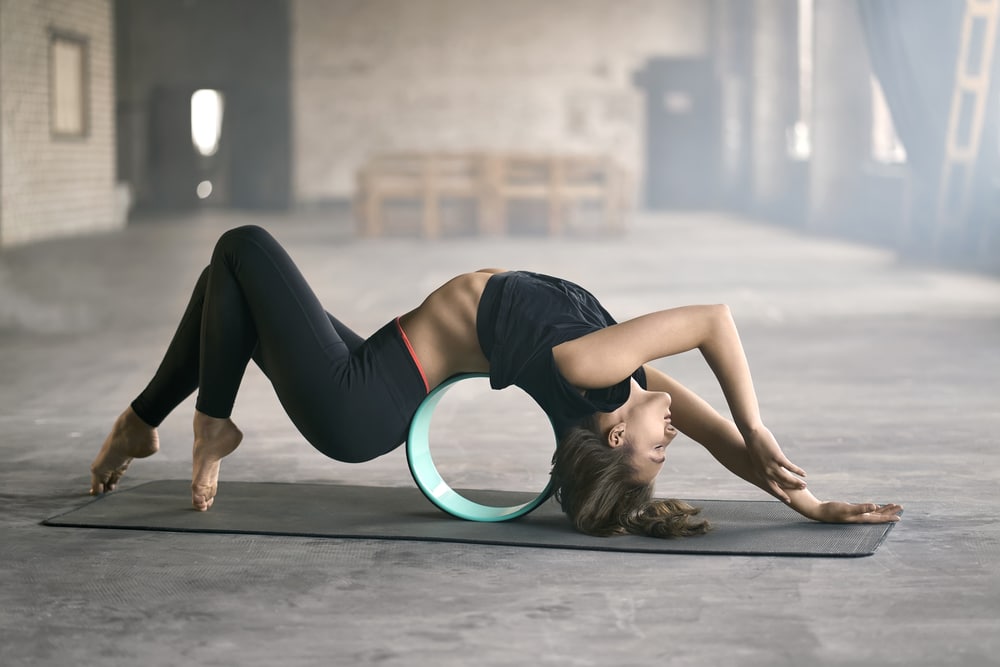
A yoga wheel is essentially just that—a wheel. Made from either wood or plastic, it’s a hollow, circular object used as a prop to enhance your yoga practice.
The beauty of this cylinder is that whether you’ve been practicing for years or you’ve never stepped on a yoga mat before, you can gain something from using the wheel.
You’ll find a deepening in your practice if you’d like to take it there, or you can use it as support if that’s more of what you need.
It’s incredibly versatile, so any practitioner can get what they need by using it. There are also multiple sizes of yoga wheels, making it even easier to find a wheel that’s perfect for your practice.
Larger wheels are great for taller practitioners, as well as for those looking to go a little deeper into certain postures—particularly in heart opening poses or backbends.
Small or mini yoga wheels are great wheels to start off with if you’re new to yoga. For those who don’t wish to go quite as deeply into the posture, mini yoga wheels are a great way to ease into it.
They’re great for helping with flexibility for newer practitioners. They can also be used more for massages, targeting sore or tight muscles in a similar fashion to foam rollers.
How Do You Use a Yoga Wheel?
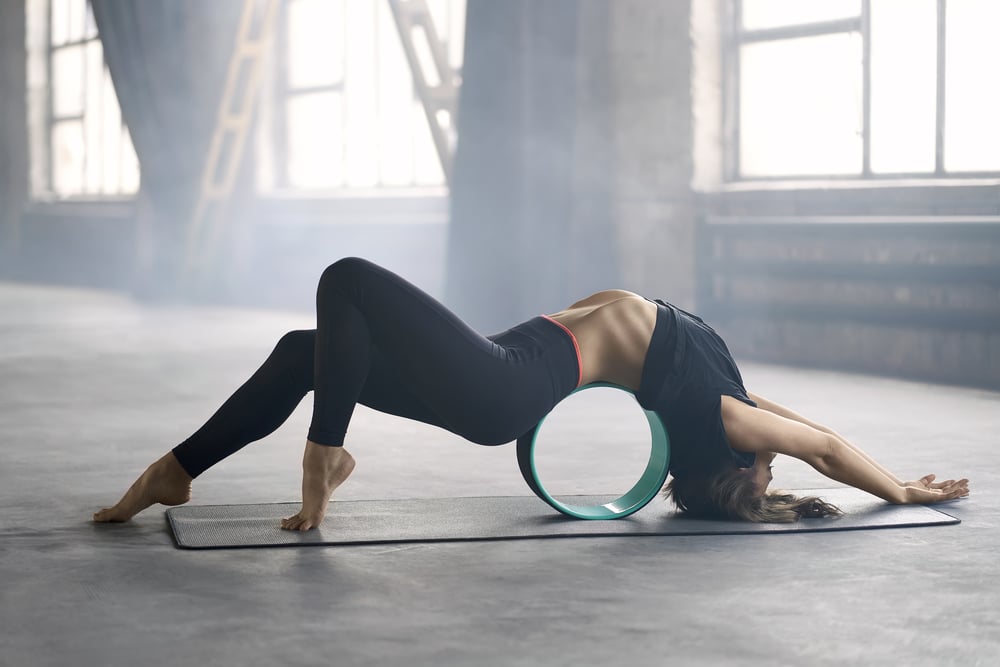
The range of things you can do with a yoga wheel is practically endless. Though they get a strong reputation for helping make backbends and heart openers more accessible as well as deeper when needed.
They also play a major role in assisting with core work, handstands, forearm stands, and other inversions.
As a beginner, using the yoga wheel can provide a great deal of support along the spine. When placed underneath the back, the wheel can actually roll along your spine to gently massage it, allowing you to safely open through the entire front of the body.
This gives you a fantastic stretch while also keeping you supported—you won’t have to worry about going deeper than you’d like.
For intermediate and advanced practitioners, the wheel is incredibly helpful in deepening your backbends while, again, keeping your body supported.
There are also plenty of fun ways to use the wheel while working on inversions. You might use it for support in a forearm stand, or roll it to the wall to use during your handstand practice.
There are also fantastic ways to use the wheel for core work in plank and other postures. The ideas are endless for utilizing your yoga wheel. It’s easy to get creative, and even make up your own exercises depending on what works best for your body.
What Are the Benefits of Using a Yoga Wheel?
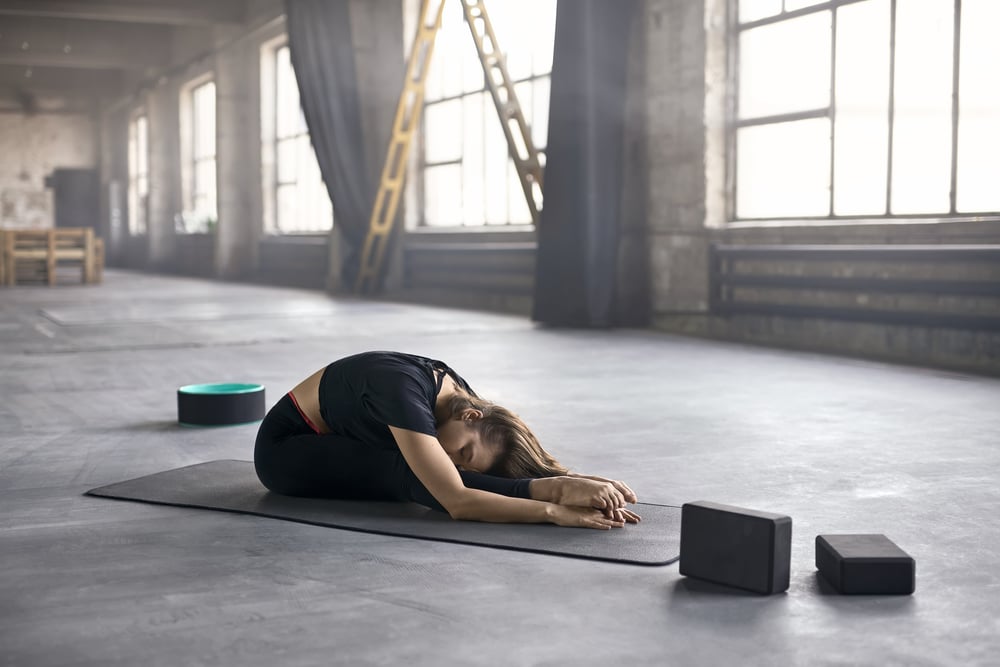
There are many benefits to using a yoga wheel in your practice. If you’re new to yoga or your muscles are especially tight through the front of your body—the shoulders, chest, abdominals, and hip flexors—practicing with a yoga wheel can really help open up these areas.
Utilize the wheel by leaning back on it, essentially laying on the wheel, and letting the spine roll along it. This will not only help lengthen the back muscles, but it can also help realign the spine.
Yoga wheels are also great for increasing flexibility. For a gentle assist, you might hold onto the wheel with your hands during child’s pose.
Having a higher surface on which to rest your hands can help create more length through the spine. Dropping your head between the biceps can help you find an even deeper stretch.
In a seated forward fold, you might put the wheel at the soles of feet, and reach forward for the wheel.
You can use it for traction in lengthening through the hamstrings and back. It can also help increase flexibility in splits, either placing the wheel under the hamstring or for an incredibly deep stretch sending it underneath the ankle.
Through increasing flexibility, using the yoga wheel can also help relieve aches and pains throughout the body.
By massaging your spine, it can help relieve tension in the back of the body while at the same time opening up through and releasing tension from the front of the body.
Similar to yoga blocks, the yoga wheel can help drastically in aiding with inversions. You might hold on the wheel during forearm stand for more support.
You might also utilize the wheel when working on pressing up to a handstand—either by resting the wheel underneath the head and against a wall, or hugging it between the hamstring and calf of your bent leg in a puppy press.
By using your yoga wheel as a prop during inversions, the wheel can actually help prevent injury.
The wheel will support you and keep you safe as your strength increases.
As it lengthens your spine and releases tension through the front of the body, it will also help to improve your posture.
Having a solid posture is great for helping to prevent chronic pain or injury.
Not only can you strengthen your core by using the wheel during inversions, but you can also use it specifically for core work while in plank.
Ultimately, the yoga wheel is there to help you enhance your practice in every way. Postures can be more accessible with the wheel, while the wheel simultaneously allows you to soften deeper into certain postures.
You can easily increase flexibility while using the wheel, while also improving your strength.
What Types of Yoga Wheels Are There?

While most yoga wheels are hollow, there are also solid yoga wheels with handles or grips to help you gain traction. Some wheels are wooden, while others are made of plastic, cork or PVC.
UpCircleSeven (Amazon link) makes several different types of wheels, although their cork option seems to be a favorite by many. This wheel has been tested to hold up to 550 lbs. of weight.
Its outer cork layer makes this wheel antimicrobial and sweat-wicking, which is great if you know you’re going to be sweating a lot during your practice!
The layer of cork is also one of the thickest seen on a yoga wheel, so it provides tons of extra comfort while you’re rolling around on it.
This wheel won’t retain odors and is eco-friendly—overall a great option to go with!
Another cork yoga wheel that practitioners are raving about is the Freory wheel. With a layer of TPE foam padding, the wheel is not only incredibly comfortable but also eco-friendly. Its frame is made with heavy-duty ABS plastic and it can hold up to 500 lbs.
Sukha Mat makes several different wheel options, ranging from wheels made purely of wood to options made of eco-friendly PC Alloy with a thick and cushiony outer layer of TPE foam.
One of the strongest wheels out there is the Risefit yoga wheel. It can actually hold up to 1000 lbs! Probably unnecessary, but it is good to know the wheel can withstand a lot.
This wheel has a dense and durable layer of TPE foam—it’s slightly less cushiony than the UpCircleSeven option, but it will last! It’s also available in lots of fun prints as well as solid colors.
The Seigla yoga wheel is made with a PVC core and thick outer layer of TPE foam. It’s also been shown to withstand up to 600 lbs. This wheel’s outer layer is not only free from chemicals but is also antimicrobial. This means you won’t need to worry about bacteria or fungal growth on your wheel—even after lots of sweating!
While all of these wheels are around 12 inches in diameter, many brands also make smaller or mini versions at anywhere from 6.5 to 10 inches in diameter.
What Is the Best Yoga Wheel for Beginners?
Beginners might appreciate starting out with a smaller wheel, as these can be a little gentler as far as how deep it can take you into a posture.
If a newer yoga practitioner is incredibly tight through their front body—the shoulders, chest, abdominals, hip flexors, and even into the quadriceps—starting off with a mini wheel might be a good idea.
Mini wheels have the same overall effect as full-size yoga wheels, but they have the ability to ease you into the posture in a gentler way.
Large yoga wheels do provide support where needed, but they can also take you much deeper into certain postures than mini wheels.
Sukha Mat makes a mini yoga wheel that is about 6.5 inches in diameter. This great for targeting certain muscles as well as starting to safely open up the body in tight areas. Note that we do recommend a different yoga wheel for those with ongoing lower back pain (see this article).
What Size Yoga Wheel Should I Purchase?
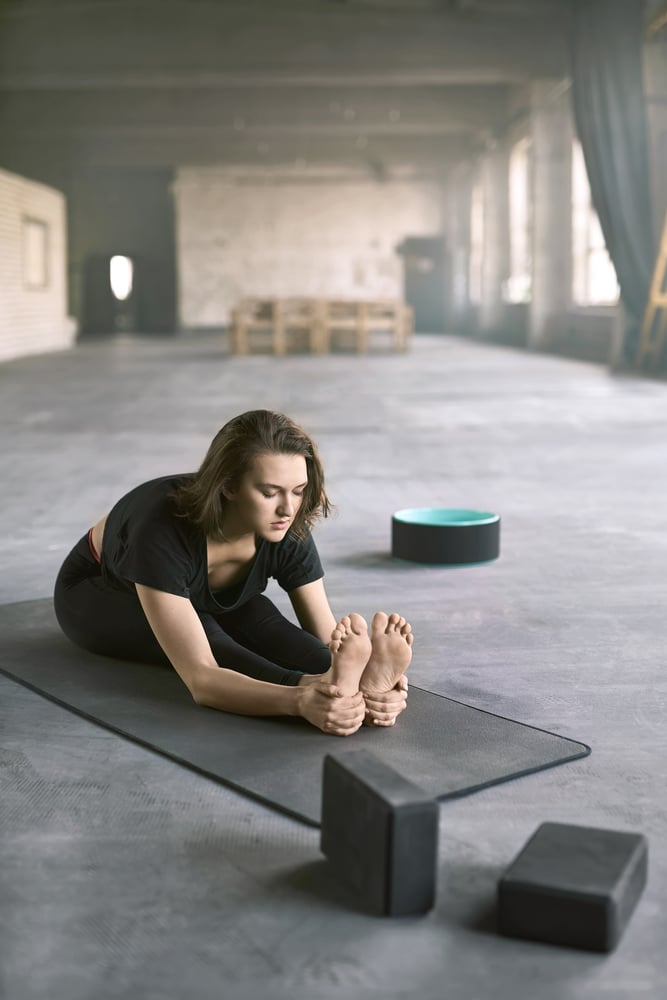
The size of yoga wheel that you decide on is completely dependent on your own personal practice and needs.
Beginners to the yoga practice might choose to start with a smaller wheel so they can ease their way into postures while also getting acclimated to the wheel.
With that said, beginners don’t have to start off with a small wheel, and small wheels still work well for seasoned practitioners.
Small wheels are also great for targeting certain muscles and helping to release through the myofascial tissues, similar to what a foam roller would do.
Larger wheels provide tons of support in inversions, creating a sturdy counterbalance. They also allow you the space to go deeper into backbending postures while still providing stability.
Larger wheels are also great for working with balancing postures. Many people will step onto the wheel for postures like tree pose and eagle pose.
While incredibly difficult to balance with one foot on the wheel, it certainly helps strengthen your body in crazy ways!
What Are the Best Yoga Wheel Exercises for Beginners?
There are so many great ways to get creative with the yoga wheel. The wheel is so diverse that while it can be used to make postures more accessible for beginners, the exercises are easy to modify for more advanced practitioners looking to go even deeper.
Check out these 6 exercises for beginners and how you can ramp them up when you’re ready!
1. Massage Through the Spine
Lean back onto the wheel, either seated or in a variation of bridge pose with the soles of the feet planted. Take a little time to gently rock back and forth on the wheel, letting it roll up and down along the spine.
This movement helps lengthen the back muscles, realign the spine and open up through the front of the body—a fantastic movement if you sit at a desk all day!
2. Core Work in Plank
In plank pose, you can rest the top of one foot at a time on the wheel for a few breaths. After you spend time with each foot on the wheel, you can place both feet up at the same time.
This added height through the legs makes plank an even more challenging posture. There’s also even more added core work in trying to stabilize the wheel as it rolls back and forth.
3. Shoulder Stand to Plow Pose
The mini wheel can work as great support beneath the low back in shoulder stand. Using the wheel here can allow you to create more length and lift through the spine, especially as you begin to work your way over into plow pose.
For more advanced practitioners, the larger wheel can help you get you even deeper into the posture by rolling up further up toward the shoulders as you stack the hips over the shoulders.
4. Forearm Stand
Beginners might slide near a wall while giving forearm stand a try with the wheel. You can slide the wheel against the wall while holding on to either side.
Bring your forearms all the way down toward the earth and use the wheel as a counterbalance as you take little hops—stacking the hips as far over the shoulders as you can.
The wall will be there for support as well! More advanced practitioners who would like to work toward forearm stand can use the wheel in this same way away from the wall.
For an even deeper backbend option, you might start to bend the knees to find scorpion, working the toes down toward the wheel and using it as support once they get there.
5. Hanumanasana/Splits
This is the perfect opportunity to utilize the different sizes of wheels depending on where your body is. If you have less flexibility through the hamstrings, you might use the larger wheel underneath the groin and rest on it.
You can also come to one knee and straighten the opposite leg out in front, resting the ankle on the wheel—similar to a half split variation. You can also rest the smaller wheel underneath the groin if you want to go a little deeper.
For an even deeper assist, you might come all the way down to a split, and rest the mini or standard size wheel underneath the front ankle, creating even more space through the hamstrings.
6. Handstand Press
While using the wheel to work on your handstand press, beginners might come to the wall to give it a try.
Hug the wheel between the calf and hamstring of one leg, while kicking off—or gently lifting up for a press—with the other. This helps activate through the legs and engage the core, which makes kicking up and pressing up much more accessible.
Give these exercises a try, and when you’re ready, ramp them up! The yoga wheel is so versatile that you’ll be having fun with it whether you’re a beginner or not!

